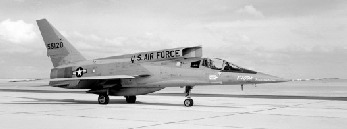
|
John A. Weeks III
Friday, January 16, 2026, 2:16:18 AM CST |
|||
| Home | Photo Tours | Rail Fan | 12 Easy Steps |
| Aviation | Spacecraft | Highways & Bridges | About The Author |

|
|
|||||||||||||||||
YF-107A — The Ultra Sabre Survivors
By the early-1950’s, North American Aviation had two very successful
fighter jet projects under its belt. The first was the F-86 Sabre.
Based on the J-47 engine, it could go supersonic in a shallow dive.
The F-86 distinguished itself in Korea with a 14 to 1 kill ratio over
the agile MiG-15. The F-100 Super Sabre was an improved Sabre built
around the bigger J-57 engine. The F-100 was the first USAF fighter
to go supersonic in level flight. The Super Sabre would go on to
distinguish itself in Vietnam, where it earned the nickname
“The Hun”.
The next logical step was a fighter jet that could fly Mach 2 in level flight. The introduction of the larger J-75 engine made a Mach 2 fighter possible, at least on paper. North American started working on such a plane under the designation F-100B. Both the F-86 and F-100 have their air intake in the nose of the aircraft. The F-100B started with this design, but it was soon found that the large radar needed the space in the nose. As a result, NAA moved the air intakes under the fuselage.

A number of events happened in mid-1954. First, the USAF issued a requirement for a tactical fighter bomber that was capable of delivering a nuclear bomb. Second, the USAF gave the go-ahead for the Mach 2 fighter bomber, however, it changed the program name to F-107. A contract for 3 flyable YF-107s was issued. Finally, the USAF gave the go-ahead for the YF-105. The F-107 had competition, and likely would end up in a fly-off. NAA put the F-107 program into high gear. It was quickly determined that the lower position of the air intake caused problems with dropping the nuclear bomb from the bomb bay. As a result, the intakes were relocated above the fuselage, something that had never been tried before. The first YF-107 flew on September 10, 1956. The YF-107 hit Mach 2 shortly after the first flight. In the end, there were a lot of problems with the F-107. The same was true of the F-105. The F-107 program lost one plane in flight testing, while the F-105 program lost both of their prototypes. Given time, the problems could have been worked out of the F-107, and it probably would have been a successful program. But the F-105 was selected as the new fighter/bomber. Given the name Thunderchief, the F-105 earned the nickname “Thud” in Vietnam, where almost 400 F-105’s were lost of the nearly 800 that were built. The YF-107 program was canceled, the two survivors were sent to NASA. NASA found the planes to be so unreliable that they were quickly retired. These two aircraft survive in museums. The lasting legacy of the F-107 is the air intakes located above the cockpit. It is a testament that every problem has solution, even if that solution is unconventional. Pilots feared that they would be sucked into the air intakes if they had to bail out, and gave the airplane the affectionate nickname of the “man-eater”. F-107 Ultra Sabre On Static Display
Note—click on the Serial Number to see a photo of each airplane.
|
|
|
Authored by John A. Weeks III, Copyright © 1996—2016, all rights reserved. For further information, contact: john@johnweeks.com
|